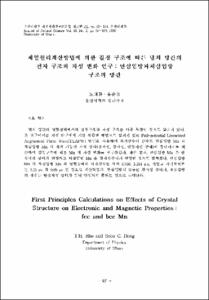朝鮮時代 嶺南班村의 形成과 發展에 關한 硏究
- Alternative Title
- A study on the Banchon(Aristocrats' villages) of Yongnam area formed in Chosun period
- Abstract
- 朝鮮時代 嶺南地方의 班村은 한국건축 연구의 중요한 자산으로 존재하고 있다. 지금까지 개개의 반촌에 대한 건축학적 조사가 학계에 보고되었으나 이들을 포괄적으로 묶어서 반촌이 형성되게된 원리나 배경에 대해 연구한 예는 거의 없다.
본 논문은 조선시대의 역사의 거시적 흐름이 영남지방의 반촌에 미친 영향을 분석하여 반촌의 형성배경을 밝히고 그 발전양상을 알아보기 위해서 9개의 반촌을 택하여 연구대상으로 삼았다.
영남 반촌의 형성과 발전배경은 대략 4개시대로 구분할 수 있는데 각 시내에 있어서의 시대정신의 흐름과 반촌의 발전에 관해 연구하였다.
1. 土性의 성장과 士族化 시대-향반층의 씨족세력이 중앙의 인준을 받아 士族化하며 현재의 종족부락의 모태가 되는 마을에 처족이나 외족의 토지를 물려받아 이주한다.
2. 영남사림파의 등장과 영남학파의 성립시대-영남양반층이 중앙정계에 대거 등장하는 시대로 이때부터 이들은 새로운 학문집단이자 정치세력으로 전국적인 영향력을 행사하게되고 향리에 더많은 장토를 마련하고 그 마을의 有力氏族으로 번성하게된다.
3. 四色黨爭 시대-영남양반이 중안정계에서 失勢하고 향리에 돌아와 지방의 세도가층이되어 경제적, 이념적 지배층으로 군림하며 그들의 근거지인 반촌은 儒學을 실천하고 후학을 교육하며 씨족을 보호하는 동족마을로 굳어져가게 된다.
4. 세도정치시대-이 시대에 영남사족의 중앙정계진출은 더욱 봉쇄되었고 이들의 지역화, 土豪化는 더욱 강화된다. 이들은 신학문이나 기술의 도임 등 시대의 요구를 외면하고 동족을 중심으로한 배타적인 반촌건설에만 더욱 집착하여 반촌은 역사적 유물로서의 기능만 남게 된다.
Banchon(Aristocrats' villages) in YongNam area still exist as important assets for the study of Korean traditional architecture. Until now architectural studies of each village have been conducted but the study of whole setting of banchon in Yongnam area to reveal the principle and background of Banchon in their forming and development has not been tried, which is the purpose of this study.
This study aims at analyzing the influence of main-stream Chosun history on the
These villages were formed and developed as the ruling class in Yongnam area became the members of the central politlcal society of Koryo and Chosun dynasties. They attended the central officialdom by Gwageo (examination for selecting bureaucrats). They moved to the villages where their mothers' or wives' families already thrived and inherited land from mothers' or wives' families. Gradually they became influential aristocrats of the nation and acquired dominant position in their villages.
After clan-struggles among aristocrats of Chosun dynasty Yongnam aristocrats lost influence on the central political society. They came back to the villages and became indigenous ruling class in Yongnam area. And as rich landlords and school owners they developed their villages to Confucious paradises and family bastions.
Banchon(Aristocrats' villages) in YongNam area still exist as important assets for the study of Korean traditional architecture. Until now architectural studies of each village have been conducted but the study of whole setting of banchon in Yongnam area to reveal the principle and background of Banchon in their forming and development has not been tried, which is the purpose of this study.
This study aims at analyzing the influence of main-stream Chosun history on the
These villages were formed and developed as the ruling class in Yongnam area became the members of the central politlcal society of Koryo and Chosun dynasties. They attended the central officialdom by Gwageo (examination for selecting bureaucrats). They moved to the villages where their mothers' or wives' families already thrived and inherited land from mothers' or wives' families. Gradually they became influential aristocrats of the nation and acquired dominant position in their villages.
After clan-struggles among aristocrats of Chosun dynasty Yongnam aristocrats lost influence on the central political society. They came back to the villages and became indigenous ruling class in Yongnam area. And as rich landlords and school owners they developed their villages to Confucious paradises and family bastions.
- Issued Date
- 1991
- Type
- Research Laboratory
- Alternative Author(s)
- Lee,Kyu-Sung
- Publisher
- 공학연구논문집
- Language
- kor
- Rights
- 울산대학교 저작물은 저작권에 의해 보호받습니다.
- Citation Volume
- 22
- Citation Number
- 1
- Citation Start Page
- 115
- Citation End Page
- 125
- Appears in Collections:
- Research Laboratory > Engineering Research
- 파일 목록
-
-
Download
 000002024759.pdf
기타 데이터 / 307.4 kB / Adobe PDF
000002024759.pdf
기타 데이터 / 307.4 kB / Adobe PDF
-
Items in Repository are protected by copyright, with all rights reserved, unless otherwise indicated.